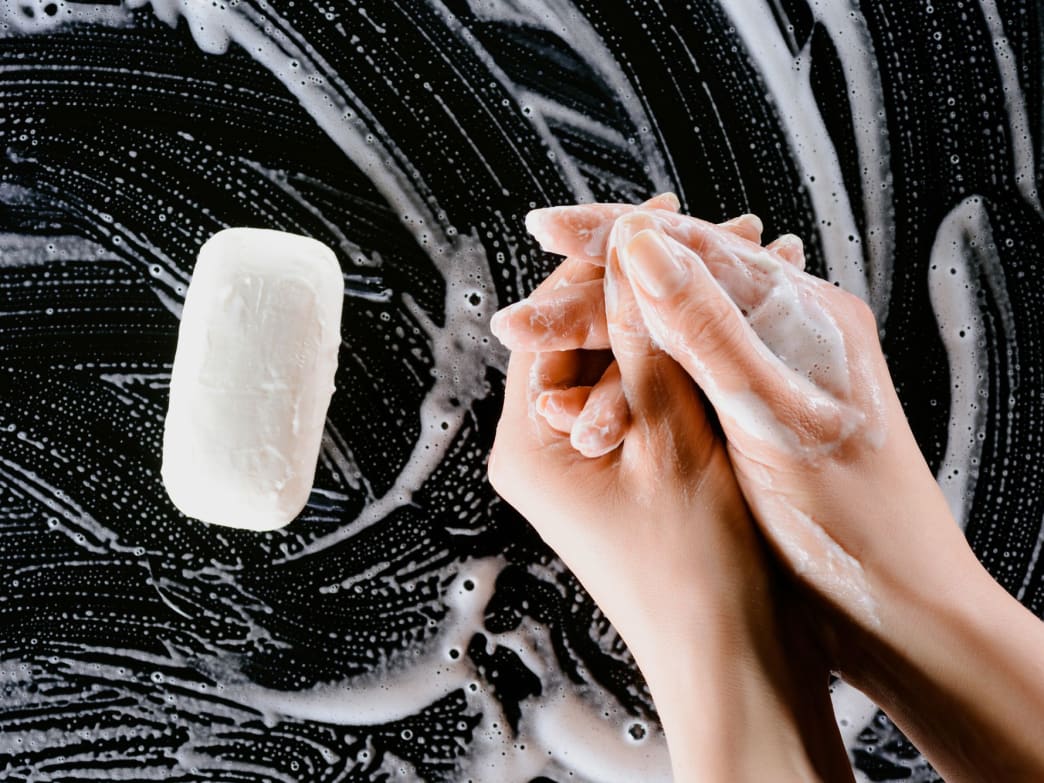
30 Tips for Nourishing Your Mind & Your Body
AT AKASHA BE WELL SKINCARE, WE OFFER ONLY THE FINEST LINE OF NATURALLY EFFECTIVE, NATURALLY BALANCED SUSTAINABLY CLEAN LUXURY SKINCARE TO BALANCE AND HYDRATE YOUR OILY SKIN. PLEASE ENJOY THE CONTENT BELOW.
Day 1. Avoid the Pitfalls of Working Too Much
Working long hours and not taking care of yourself can spell disaster for your health. Here are a few tips from Envolve, an integrated healthcare solutions company, to balance your work and personal life:
- Plan and Prioritize. Get a notebook and start writing down ways you can incorporate healthy habits into your schedule. Do you want to eat healthier? How about stop checking emails after dinner? Prioritize what you want to achieve and set realistic expectations.
- Slumber Smartly. Sleep directly affects your mood, productivity, and decision-making, so strive to get the recommended 7–8 hours each night. A consistent bedtime and wake time encourages your body and mind to get into a rhythm that helps you feel rested throughout the day.
- Alleviate Anxiety. After a long day of work, it’s crucial to unwind and let go of your stress, if only for a few minutes. Clear your mind, unplug, and be present in the moment so you’re able to enjoy the things and people around you. For example, try a meditation practice or yoga, or listen to music.
- Increase Enjoyment. It’s important to plan activities that you can look forward to during the week. Read for enjoyment, meet up with friends, or cook your favorite meal with a loved one. Studies have shown that people who are in satisfying committed relationships have fewer health issues and live longer.
Day 2. Ease PMS with Vitamin B6 & Calcium
If you suffer from water retention, tender breasts, cravings for sweets, headaches, migraines, aches and pains, insomnia, backache, acne, depression, irritability, and/or lethargy 1– 2 weeks before your period, two nutrients may help. Vitamin B which doesn’t work overnight, is worth adding to your supplement regimen if you have premenstrual syndrome (PMS). According to one trial, the vitamin reduced pre-menstrual headaches in 80 percent of women. It’s also known to help lessen depression and aggressive tendencies during PMS. Consider taking calcium too—calcium levels drop about 10 days before menstruation, suggesting that a deficiency could cause water retention, cramps, headaches, and tension.
Day 3. Think of Vitamin C for More Than Colds

You may associate vitamin C with immune health, but this important vitamin has a lot more going for it. It’s necessary for the production of collagen, a shortage of which contributes to skin sagging, joint deterioration, and other signs of aging. It’s also known to help prevent the buildup of cholesterol deposits. Taking aspirin for long periods of time can impair the absorption of vitamin C, so you may need to boost your intake if you use aspirin on a regular basis.
Day 4. Incorporate Mindfulness into Workouts
Certified personal trainer Corey Phelps believes the practice of mindfulness can be applied “just about anywhere and in any type of workout.” That means not just on a yoga mat. One way to cultivate mindfulness, says Phelps, is to set an intention. Prior to jumping into a workout, take a moment to consider what you want to achieve during your time. Defining a concrete goal can serve as a compass during your workout. This is something you can return to if motivation dips or focus is lost.
Day 5. Sip Smartly
Americans use and discard 500 million plastic straws each day, according to nonprofit group The Last Plastic Straw. That adds up to more than 175 billion straws each year piling up in landfills and littering our environment. If you can’t bring yourself to sip your favorite beverage without a straw, recyclable paper straws are a good option, but reusable stainless steel straws are even better. You can find a set of six for less than $10, then take them with you to restaurants and bars and ask the staff to “hold the straw” on any drinks you order.
Day 6. Bee Environmentally Friendly
Plastic sandwich baggies are another unnecessary drain on our environment—according to some estimates, by the year 2050, there will be more plastic in our oceans than fish. Luckily, environmentally friendly options abound. Take your pick from reusable silicon, cotton, and BPA-free plastic bags, one of which can replace more than 350 conventional baggies. Or try a Bees Wrap beeswax sandwich wrapper. Handmade in Vermont, these washable, reusable, compostable wraps last about 1 year when used several times each week. They cost about $11 each, roughly the same as one large box of Ziploc plastic sandwich baggies.
Day 7. Steer Clear of Everyday Skincare Sins
What’s getting in the way of having beautiful skin? Here are a few surprising skin saboteurs from London-based doctor Maryam Zamani:
- Washing with Tap Water: Hard water tends to be more alkaline, which impacts the slightly acidic pH of skin. If this pH is disrupted, it can cause a flare up and make it harder to retain moisture in the skin. Try no-rinse cleaners, water filters, and/or a slightly acidic cleanser (to combat alkalinity in hard water).
- Smartphone Sins: Holding the phone to your face can increase skin allergies and outbreaks. Bacteria from dirty hands, sweat, and makeup all affect your skin. Regularly clean your screen or invest in earphones or a wireless headset.
- Tech Neck: Looking down at your screen leads to aging around the face and stress on the neck muscles. It also creates folds in the skin, causing it to look untoned and slack. Hold gadgets at a neutral eye level to avoid looking down for long periods.
- Seasonal Allergies: Seasonal allergies are the most common causes of dark circles under the eyes. The congestion, even when minor, causes the veins that drain from the eyes into the nose, to increase in size and become darker.
- Overexfoliating: If you overexfoliate, it can cause your skin to become inflamed. Use exfoliants sparingly, no more than 2–3 times a week.
Day 8. Make a Restaurant Plan
Many of us struggle with trying to stick to our diet when dining out. “The challenges to navigating restaurant meals are many,” says Jill Weisenberger, who partnered with the American Diabetes Association to write Prediabetes: A Complete Guide: Your Lifestyle Reset to Stop Prediabetes and Other Chronic Illnesses. “Portions are often huge, it’s hard to know which foods are swimming in sugar and saturated fats, and what sounds like a wholesome wrap or salad may be a calorie bomb in disguise.”
You can eat away from home without blowing your diet, says Weisenberger. Most important: Make a plan, and stick to it. “Before heading to the restaurant, set your plan,” she says. “My most successful clients preview menus online and make their choices at home in a leisurely environment. They give themselves time to think through their options instead of being influenced by the orders of dining companions or nudges from the waitstaff. Last-minute choices are frequently less healthful.”
Day 9. Focus on Figs
Tired of the same-old, same-old snack foods? Next time you’re feeling the urge, grab a handful of figs. They’re packed with fiber, potassium, calcium, and antioxidants, and are naturally fat-, sodium-, and cholesterol-free. Select plump, fragrant figs that are soft and yielding to the touch, but not mushy. If they smell slightly sour, they have already begun to ferment. Fresh figs should be refrigerated as soon as possible and can be stored for up to seven days. There are two fig seasons—early June and August through October.
Day 10. Eat Your Way to Better Sleep
Tired of being tired? Certified Nutritional Health Counselor Sara Siskind recommends four foods that can help:
- Tart Cherry Juice —Researchers from Louisiana State University concluded that drinking the juice of Montmorency tart cherries twice per day for two weeks helped increase sleep time by nearly 90 minutes among older adults with insomnia.
- Pistachio Nuts —Besides being a powerhouse of heart-healthy fats, protein, and fiber, pistachios also contain a significant amount of vitamin B, which can help to induce sleepiness. According to the Alaska Sleep Clinic, a deficiency in B has been linked with lowered serotonin levels and poor sleep.
- Bananas —They’re full of magnesium and potassium, which are natural muscle relaxers that can help your body to unwind.
- Kiwis** —These fruits contain a significant** amount of sleep-promoting serotonin. Researchers at Taiwan’s Taipei Medical University found that eating kiwi on a daily basis was linked to substantial improvements in both quality and quantity of sleep.
Day 11. Get a Proper Bike Fit
“A cyclist’s position on the bike has to balance aerodynamics, power output, and comfort. The more you pursue any one of the three, the more the others suffer,” writes Chris Carmichael, CEO and Head Coach of Carmichael Training Systems in Santa Ynez, Calif. For road bikes, you want your weight distributed as evenly as possible between the wheels, says Carmichael. Sitting too upright means less weight on the front wheel—and less control, traction, and stability. “Get a bike fit that allows you to feel comfortable handling your bike … not one that just makes the bike more like an easy chair.”
Day 12. Pick the Right Wood for Grilling
Steven Raichlen knows a thing or two about grilling. He’s written 31 books on grilling, filmed seven TV series, taught two decades of Barbecue University classes, and written hundreds of articles on the topic. In his newest book, Project Fire, Raichlen offers this grilling hack: “If I could pick one wood for grilling, it would be oak, which is full-flavored enough to stand up to beef, yet neutral enough to grill the most delicate poultry or seafood without overpowering it. Avoid soft woods, such as pine and spruce for grilling (they put out a resinous sooty smoke).”
Day 13. Save Your Skin with Lycopene
Lycopene, a potent antioxidant found in tomatoes, is best-known for promoting prostate health. But did you know that it can also prevent—and maybe even reverse—sun damage to your skin? Several studies have shown that lycopene can protect against burning from the sun’s UV rays. In one, healthy adults who ate 5–10 mg of lycopene (also found in apricots, pink grapefruit, guava, and watermelon) for 12 weeks decreased sunburn by approximately 50 percent. “Lycopene is the best at mopping up free radicals, so it protects against sun damage for the skin,” says Mark Menolascino, MD, an integrative physician in Jackson Hole, Wyo. “It has the ability to work in multiple areas by becoming that free radical scavenger.” As a supplement, take 20 mg of lycopene daily.
Day 14. Use Sunscreen, Even on Cloudy Days
“Always apply SPF sunscreen if you plan to be outdoors for an hour even during cloudy days, as research proves that strong rays of light get through and can cause skin damage,” says Enrique Ramirez, esthetician and founder of the spa Face to Face NYC. Also, says Ramirez, avoid direct sun exposure between 10 a.m. and 4 p.m. if possible—that’s when the sun is at its strongest.
Day 15. Eat More Veggies at the Ballpark
A hot dog and a beer may be the traditional baseball meal, but these days, most sports fans are looking for something a little healthier. Enter VeggieHappy.com, a unique online tool that makes it easier than ever to enjoy a game or concert without loading up on junk food.
By partnering with food service companies that contract with ballparks, stadiums, and other large venues, the site highlights plant-based menu options and where to find them. Listings are free, and venue representatives can upload and manage them right from the website. Visitors can easily reference menu information from any device, share venue listings via social media, and post reviews about their own plant-based food experiences.
Day 16, 17 and 18. Cook Smarter
The New York-based Natural Gourmet Institute (NGI) has been providing innovative, health-supportive culinary education since 1977. Its culinary community is made up of cutting-edge chefs in the world of vegan and plant-based eating. Here are 3 tips and tricks used by NGI teachers and chefs:
- Poke a hole in a lemon and squeeze the juice you need if it’s only a small amount; the remainder will last longer.
- Freeze sauce, stock, or leftover red wine in ice cube trays, and then add to dishes straight from the freezer.
- Rather than cutting all the ingredients for a recipe before starting cooking, chop in the order that they are used. Start the first ingredients cooking and add subsequent ingredients as they are ready. By the time the last ingredient is prepped, the dish is almost ready.
Day 19. Lean on Seeds
Flax, chia, pumpkin, sunflower and other seeds make protein- and fiber-rich replacements for grains that won’t spike blood sugar and set off cravings. To make “flour,” finely grind flax and chia in a spice mill or clean coffee grinder. Use a food processor or high- powered blender such as a VitaMix to grind larger seeds; be careful not to overprocess or you’ll end up with seed butter. Use these to fortify cookies, crackers, pancakes, muffins, or breads, to add nutrients and a nutty, rich flavor that will keep you satisfied.
Day 20. Keep Your Nasal Passages Healthy
The lining of the nasal passages must have plenty of vitamin A to be healthy. This vitamin guards the linings of all body openings. Keeping nasal passages moist and healthy helps prevent post-nasal drip, nasal congestion, and colds. Vitamin A also plays an important role in overall immune and skin health. Avoid taking more than 25,000 IU daily, as excessive amounts of vitamin A can be toxic, and are especially dangerous for pregnant women. Beta-carotene is the plant-derived form of vitamin A.
Day 21. Trim Down with Yoga
Researchers at the National Institutes of Health interviewed people who had lost weight with yoga after struggling, unsuccessfully, with other methods. In addition to improved muscle tone and metabolism, yoga benefits included less stress and stress eating, reduced appetite, fewer cravings, more mindful eating, a better mood, greater self-esteem, social support, and healthy role models. “This weight loss experience was markedly different than past attempts,” the researchers concluded, “in that the weight loss was easier, and subjects
felt more confident in their ability to maintain lasting weight loss.”
Day 22. Look to Lecithin for Gallstones
If you want to prevent gallstones, try adding lecithin to your diet. Lecithin is a fatty substance that the body manufactures, and it’s a natural emulsifier, which means it helps break up particles of fat. In the gallbladder, lecithin may help digest and emulsify fats in foods. You can take lecithin in supplement form or eat more lecithin-rich foods such as egg yolks, grass-fed raw dairy, meat, and soybeans. [Editor’s note : Talk to your doctor first if you have gallbladder disease.]
Day 23. Kick Candida to the Curb
One of the most effective agents in combating candida overgrowth and other nonspecific vaginal yeast infections is tannic acid, says Emily A. Kane, ND, author of Managing Menopause Naturally and Better Nutrition’s Ask the Naturopathic Doctor column . The tannins bind to the yeast and help prevent it from attaching to the host mucous membranes (gut, vagina). Black tea, witch hazel, and goldenseal are all high in tannins and have proven helpful for controlling candida. Goldenseal is also an excellent source of berberine, which is healing to all mucosal surfaces in the body, including the mouth, bladder, and lung cells.
Day 24. Ripen a Hard Avocado

Avocados, along with bananas, release ethylene gas, which is key to the ripening process, says Lucky Jessop, author of The Goodness of Avocado. “Place your unripe, hard avocado in a brown paper bag (or other container—an empty bread bin or cake tin works well). This will trap the ethylene gas and help it ripen more quickly,” says Jessop, who adds that you can also add a banana to the bag to increase the amount of ethylene gas. Store at room temperature.
Day 25, 26 and 27. Become a Vegan BBQ Master
Veggies and vegan meat alternatives taste great when grilled. Here are three tips from Nadine Horn and Jorg Mayer, vegan grilling pros and authors of VBQ: The Ultimate Vegan Barbecue Cookbook:
- Blanch tempeh before putting it on the grill. Cut the tempeh into slices and blanch for 7–10 minutes in salted water. Then drain and pat dry. Blanched tempeh becomes flexible, loses its pungent smell and taste, and absorbs marinades better.
- Use plenty of oil when grilling tofu. Dry tofu will stick to a grill faster than you can count to three. To prevent this, tofu slices seasoned with a dry rub should be brushed with plenty of oil before being placed on the grill, and any marinades should contain a large proportion of oil.
- To grill asparagus, brush the spears with plenty of olive oil and lay them (preferably in a perforated container) on the grill over direct heat. They need only about 90 seconds. They’ll still be crispy, but with lovely char marks and a smoky aroma.
Day 28. Clear Brain Fog
“Ever feel socked in by brain fog? That’s the cloudy quality at work,” says Kate O’Donnell, an Ayurvedic practitioner, yoga instructor, and author of Everyday Ayurveda Cooking for a Calm, Clear Mind. “Foods that clog the channels increase this feeling,” she says. The top offenders? Cold milk and cheese, white flour, trans fats, toxic chemicals, alcohol, pharmaceutical or recreational drugs, and avoiding exercise. “A clear head results from foods that digest clearly and do not leave a residue. These include fruits and vegetables with a high-water content, clear soups, herbal teas, water, and meditation.
Day 29. Swap Manuka Honey for Sugar in Coffee
Substituting Manuka honey for other sweeteners gives you a sweeter coffee that’s easier to process and provides you with other important nutrients like antioxidants, minerals, enzymes, and vitamins. Manuka honey also tastes great in iced tea, lemonade, lattes, punch, and other sweetened beverages. Manuka honey comes from New Zealand. Look for high-quality, non-GMO brands such as Wedderspoon.
Day 30. Don’t Fall for the Exercise Myth
While physical activity is definitely necessary, beneficial, and burns more calories than sitting around or sleeping, it won’t beat an unhealthy or overly generous diet. As a rule of thumb, walking or running a mile burns about 100 calories. Are you willing to literally go the extra mile to burn off a single 100-calorie snack pack or a 300-calorie donut?
Written by Better Nutrition Editors for Better Nutrition and legally licensed through the Matcha publisher network. Please direct all licensing questions to legal@getmatcha.com.




Leave a comment
This site is protected by hCaptcha and the hCaptcha Privacy Policy and Terms of Service apply.